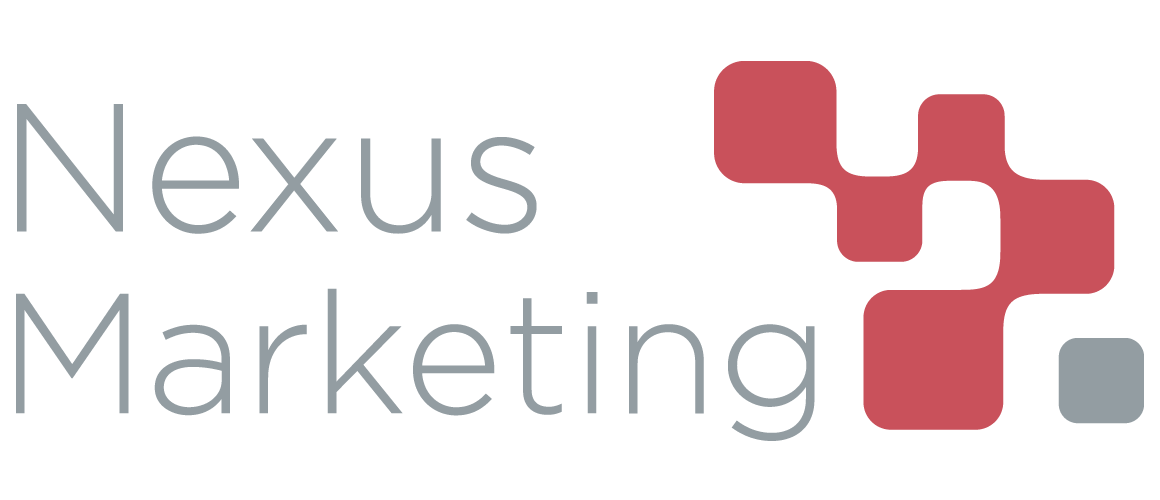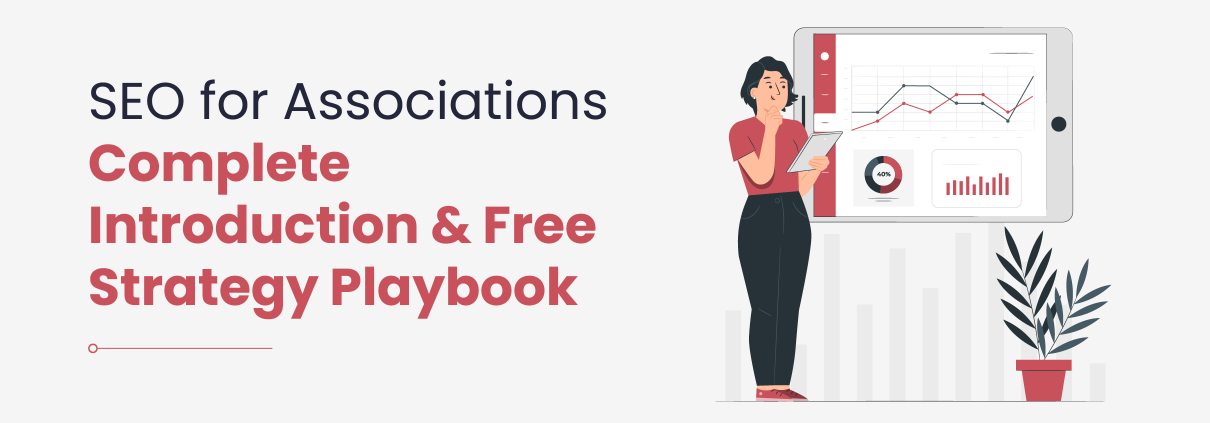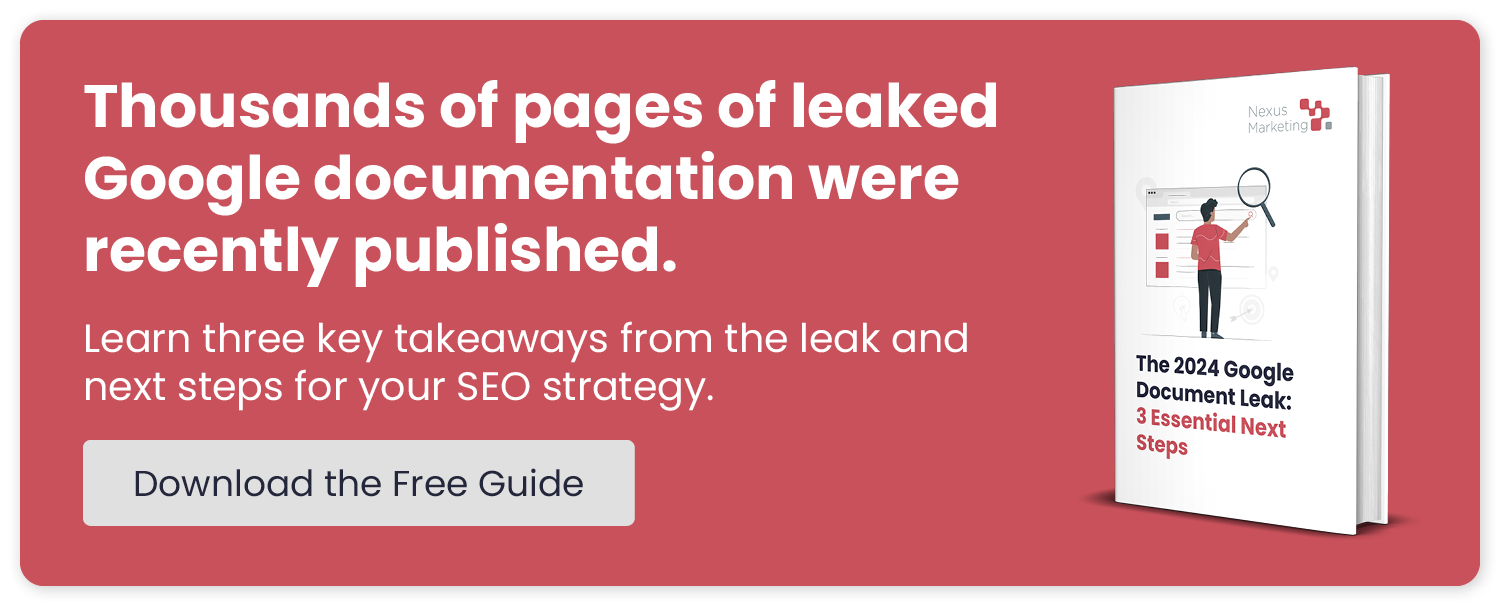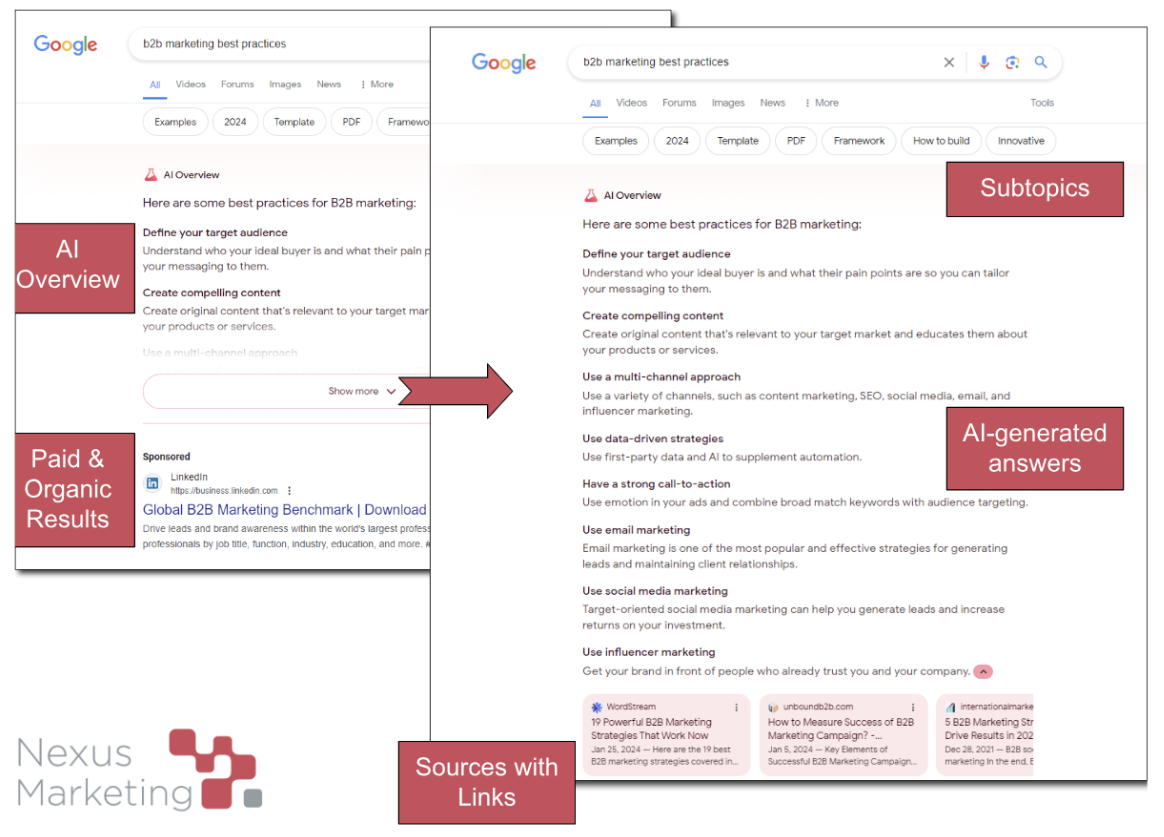SEO for Associations: Free Strategy Playbook
A user does a quick Google search for a training service or professional certification they need.
What if your association was the very first thing they see?
Search engine optimization (SEO) isn’t just for big for-profit brands—any organization that promotes its programs, services, and products to online audiences can benefit from an SEO strategy. Yes, that includes associations!
There’s a common misconception that SEO involves some kind of wizardry to achieve top rankings on search engines. Far from it.
SEO is built on straightforward technical and marketing concepts. Master them, put them into action, and you’ll build a solid SEO foundation for your association in no time. We’ll cover them all here:
Why take our advice? Nexus Marketing has been helping mission-driven brands grow their online visibility and demand generation for a decade now.
In that time, we’ve seen tons of SEO trends come and go. We know the steadfast best practices that drive real, sustained success, and our goal is to help more organizations cut through the clutter and buzz.
What is SEO?
First, the basics. Search engine optimization (SEO) is the process of technically maintaining your website and publishing high-quality content to appear higher in organic search engine results.
Within the broader field of SEO, you’ll encounter related sub-fields of more specific practices. These include:
- Technical SEO: The practice of improving and maintaining the technical quality of your website so it offers positive user experiences and search engines understand it.
- Keyword strategy: The process of choosing strategically important keywords that your organization wants to rank highly for to achieve its marketing goals.
- Content strategy: The practice of creating and updating high-quality web content that’s optimized for technical performance, keyword relevance, and user experience.
Quick context: Organic search results are any that are not paid ads (like the Google Ads that you’re likely used to seeing). Search engine results pages are often referred to as SERPs, which we’ll use in the rest of this guide.
What are the Goals of SEO?
Organizations of all types and sizes use SEO strategies to rank higher for their target keywords. By ranking higher, they can:
- Generate more sales leads for their products and services
- Increase traffic and engagement from qualified audiences
- Grow their online visibility and brand recognition
Spoiler Alert: Effective, ongoing SEO has a powerful flywheel effect.
In other words, when your website is trusted as a source of high-quality content, it’s more likely to rank higher for a wider range of keywords, further growing your visibility (and incoming sales leads).
Here’s an example: One of our clients was an early member of our free partnership program to receive high-quality content from the Nexus team.
Since joining as a full SEO client, they’ve quickly been able to put their library of content to work for their brand. Clickthrough rates increased by 118% in just 6 months, and their website now ranks on Page 1 for 32 high-priority keywords! Check out the case study to learn more.
Why SEO Matters for Associations
SEO is a smart investment for associations for several reasons:
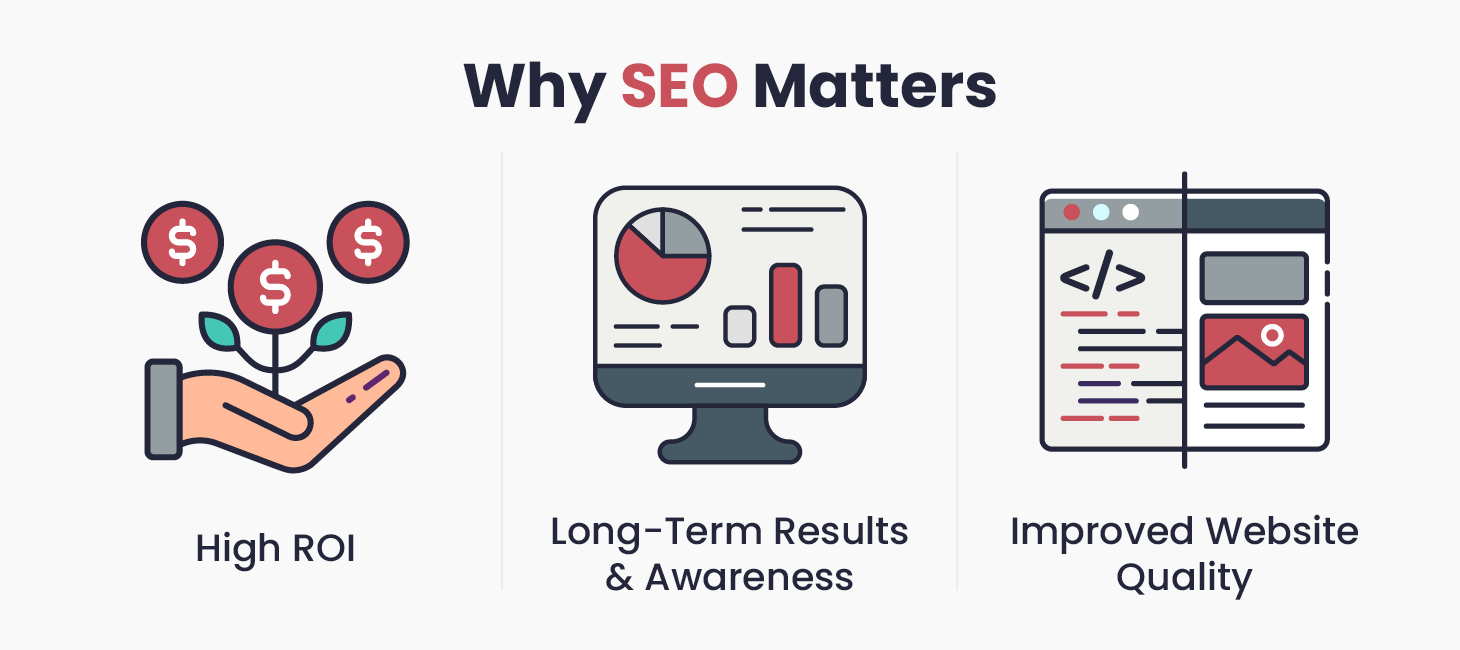
- When done well, it offers a high ROI.
- SEO is relatively low-cost compared to other marketing channels. It’s possible to make big SEO gains for free when you follow best practices, although many organizations partner with SEO agencies to reduce workload and boost their results.
- Another reason that SEO offers such a high ROI is that it allows you to target highly qualified audiences. If someone searches for a niche training program in a specific industry, SEO ensures your association reliably appears front and center.
- Compared to pay-per-click online ads, SEO generally offers a better ROI—between roughly 500% and 1,300%. The results of an effective SEO strategy increase over time, but its fixed costs do not (unless you want to really increase your SEO activities). Ads incur a cost with each click, meaning strategy mistakes are costly.
- It drives long-term results and brand awareness.
- SEO is truly a growth investment. As mentioned above, an effective SEO strategy acts like a flywheel—attracting more attention and achieving higher rankings as your website’s authority grows. This kind of organic growth is a powerful marketing force that will establish your association as a go-to resource for all things related to your industry or niche.
- It results in all-around better websites.
- SEO teaches us to be more thoughtful and strategic about how we use our websites as marketing and engagement tools. When you prioritize your SEO and follow a robust content strategy, you’ll have a technically polished website and a library of high-quality web content.
- These across-the-board improvements make stellar impressions on visitors, no matter how they found your website. Give them a helpful, positive experience, and they’re more likely to stick around and learn more about your association.
TLDR: Like other mission-driven organizations, associations often have tight budgets. SEO offers a lower-cost, higher-ROI way to drive sustained marketing results, increase brand awareness, and create better user experiences.
Essential Points to Remember
To succeed long-term with SEO, you need to keep a few North Stars in mind. Here are the essential reminders that we often discuss with our SEO clients:
- SEO is a long game. You might see fast results (and we often do), but the biggest impact comes in the months and years after you’ve implemented and maintained an SEO strategy.
- It’s an iterative process. Unlike ads, there’s no need to get your SEO strategy and content 100% perfect the first time! Google constantly recrawls content to check for quality, so you have endless opportunities to study your results and improve over time.
- Consistency and quality are key. SEO should be an ongoing priority to keep showing Google and readers that your website is worth paying attention to. Especially in the age of AI (more on this later), excellent content written for and by humans will reign supreme.
- Understand your SEO objectives. Strategies can easily derail when you focus on the wrong goals, like web traffic metrics. Search algorithms change constantly, some keywords see highly seasonal traffic patterns, and other keywords are just extremely competitive. There are all kinds of reasons why leading metrics will distract you from the real objective—generating leads.
Simply put, demand generation should be your goal, not leading metrics like web traffic.
A Closer Look at SEO Goals for Associations
Keep in mind that SEO is better for marketing some types of your association’s offerings than others:
When you focus your SEO strategy on these kinds of recurring or ongoing revenue sources, you create a much clearer path to success.
We advise our clients that short-term, one-time, or highly localized goals are better supported with other marketing channels like direct email outreach, paid ads, social media, or specialized local SEO services. In other words, SEO should be an ongoing, foundational marketing activity on which you can layer additional channels and campaigns as needed to support specific objectives.
Want an example of how SEO and other marketing strategies play well together? Check out our write-up of the top ways to integrate pay-per-click and SEO campaigns to drive success.
How SEO Works
With the context squared away, let’s get into the nitty-gritty—how does SEO work? How does a page go from unranked to dominating the SERP?
Here’s a condensed rundown of the basics of SEO:
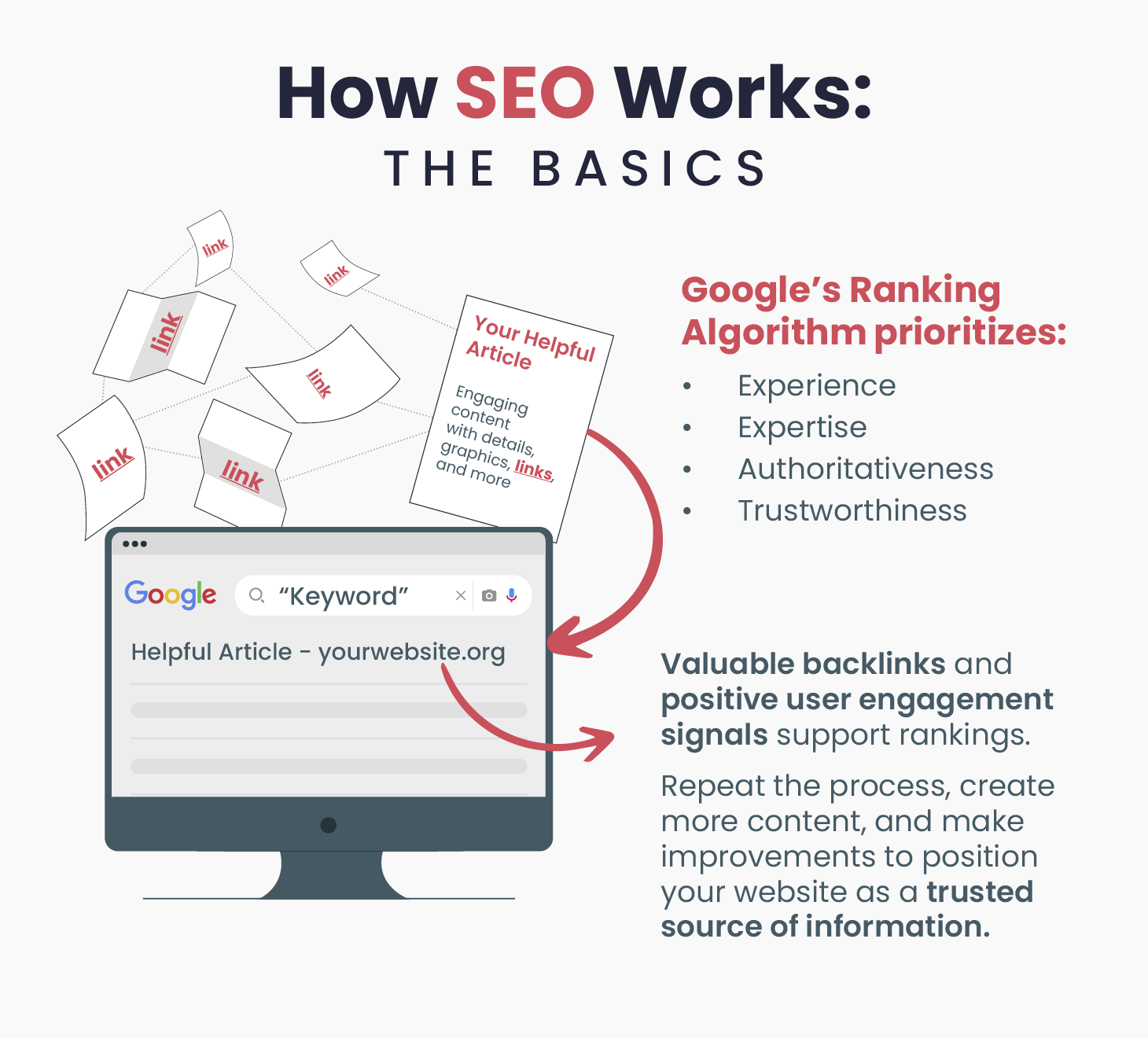
1. Search engines like Google use crawler bots to explore the internet. They screen content, pick up on keywords and concepts, check out linked pages, and log its contextual information as part of its algorithmic ranking system.
This process is called indexing. If a page is unable to be indexed, it won’t appear in Google results and is likely the result of a technical issue that should be fixed.
2. Google pays extra attention to links. When one website links to another, Google considers this a kind of vote of confidence or a little stamp of approval that says, “I trust this source enough to show it to my audience.” Over time, pages accrue backlink profiles of all the other pages on the internet that link to them.
3. Pages are analyzed and ranked for EEAT. EEAT stands for Experience, Expertise, Authoritativeness, and Trustworthiness. While it’s a somewhat fuzzy concept, EEAT is a helpful shorthand for understanding how Google defines truly “helpful,” rankable content. Let’s take a closer look at these criteria:
-
- Experience. Does the page’s author and/or the website domain have relevant experience with the topic and a history of publishing about related topics?
- Expertise. Does the content demonstrate actual expertise, i.e. correct information, relevant details, helpful insights, anecdotes, and more?
- Authoritativeness. Does the content have links from other high-quality pages across the internet, and are those links contextually relevant (that is, not spammy)? Does the website publish other helpful content?
- Trustworthiness. Does the website come from a recognized brand, organization, or person? Does it provide transparent contact information? Has it been flagged for improper SEO practices in the past?
There’s some overlap between these concepts, but taken as a whole, they give us a reliable picture of the content Google wants to serve its users.
4. When users search keywords or longer phrases, Google delivers a mix of content. Google will make assumptions about the user’s intent from the keyword—what they’re trying to accomplish with their search—which informs the mix of SERP features it delivers.
These always include organic results, pages that have organically demonstrated their EEAT to Google. Most SERPs also include pay-per-click (PPC) ads, which are indicated with “Sponsored” taglines.
SERPs usually also include a mix of other features designed to quickly provide answers and satisfy that particular user intent.
Extra Context: Types of SERP Features
The biggest new SERP features to be aware of are AI Overviews (more on these below), but other common features include:
- Featured Snippets
- Discussions and Forum listings
- Image results
- People Also Ask suggestions
- Product carrousels
- News story carrousels
- Local business listings
- And many, many more
Google scrapes relevant content to populate these SERP features. This is usually an indication of high quality. If your page gets highlighted in a Featured Snippet, you’ll secure even more valuable SERP real estate!
5. User engagement signals impact the ranks over time. Based on how users engage with the results on SERPs, Google’s ranking algorithm refines its inferences and makes adjustments over time.
SERPs never stand still for long. In addition to user engagement signals, rankings can change for all kinds of reasons:
-
- New competing content gets published
- Older content on the SERP gets updated and improved
- Other EEAT signals change (like a page’s number or quality of backlinks)
- Or the Google algorithm gets updated to prioritize a slightly new balance of factors
It’s important to keep track of your SEO performance and identify slippages so that you can make targeted content improvements—we’ll explain this process in the playbook below.
6. Google comes to recognize some domains as more authoritative than others. As a website publishes more high-quality SEO-optimized content, keeps it updated over time, and accrues more backlinks, Google recognizes that domain as a reliable source of helpful content about its core topics. It then gets prioritized in more SERPs—a powerful flywheel effect that amplifies your SEO success.
To measure a domain’s authoritativeness, SEO professionals use a variety of proprietary metrics. At Nexus Marketing, we’ve long relied on Moz’s Domain Authority score as a rough gauge for comparing how well-established a website is in the eyes of Google.
TLDR: Google constantly screens content for quality, EEAT signals, and backlinks. Content is algorithmically ranked using complex mixes of hundreds of factors, including user engagement metrics.
Over time, Google comes to recognize domains for high-quality content about their particular topics and prioritizes them to rank for more keywords.
Key Elements of SEO-Optimized Content
Ok, so you understand how Google ranks content. In tactical terms, what are the specific elements that your organization’s content needs to catch Google’s attention? Good question.
The Nexus team spends all day thinking about, researching, and writing SEO-optimized content for our clients and partners. Here are our top recommendations and the specific elements we always include in SEO articles.
Our Top Advice for Creating SEO Content
Our three most important rules of thumb for creating effective SEO content:
- Satisfy the user intent. Understand what users want when they search your target keyword.
- Don’t clutter the content. Answer users’ questions and create a positive experience.
- Offer real value, expertise, or something new—in the AI age, you have to go the extra mile to stand out.
From these tips, you can probably tell that there is no one-size-fits-all SEO content template you can follow for SEO success. Stuffing keywords into a generic article and hitting publish may have worked once upon a time, but those days are long gone.
Users and Google alike want quality content from trustworthy sources that’s tailored to the audience’s needs. If the keyword calls for a long, educational guide, that’s what you should create. If the keyword calls for very short definitions and quick bits of information about a product or service, create that content.
Elements to Optimize in SEO-Optimized Content
There’s no single template for SEO content, but there are specific technical elements that any web content intended to rank should include:
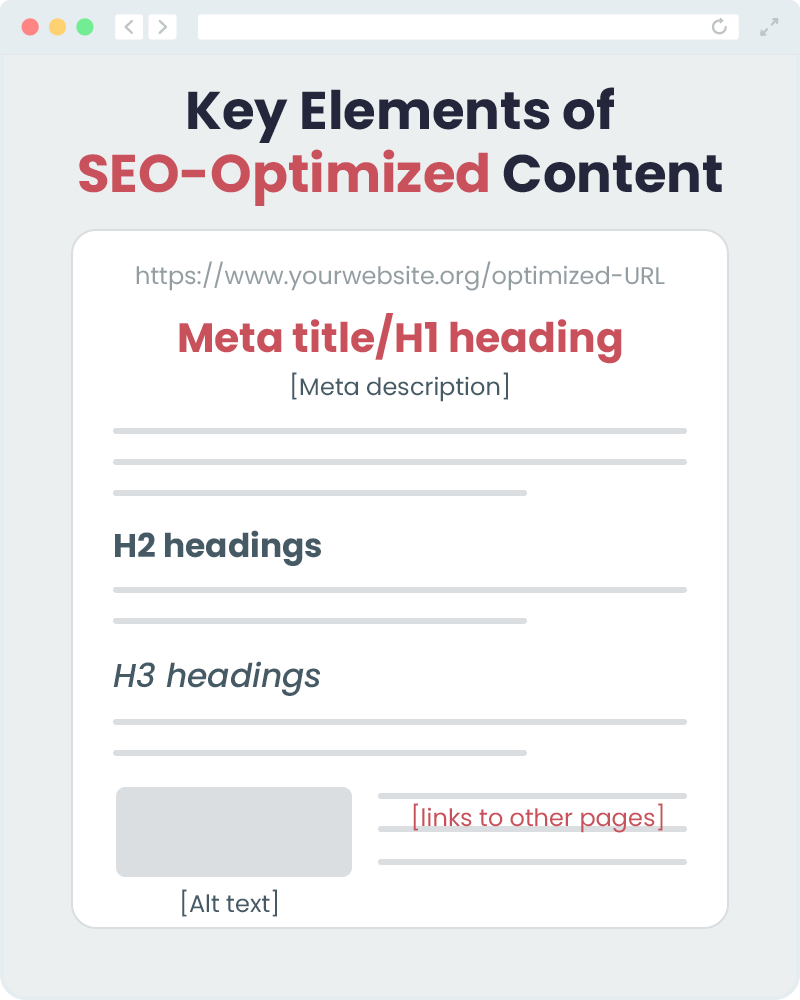
- The page’s meta title and H1 heading (which may not be the same—always worth checking) should include the page’s primary target keyword.
- The page’s meta description, or the teaser excerpt that gets displayed on SERPs, should also include a relevant keyword and entice users to click.
- Other H2 and H3 headings should include a mix of natural keyword variants and logically organize the content.
- An optimized URL that isn’t too long and includes a relevant keyword Google can quickly recognize.
- Alt text for any graphics included in the content that briefly describes what the graphics represent.
- Content should ideally include links to other relevant content on the same domain and reputable external websites.
- The page’s and website’s design should create positive desktop and mobile viewing experiences.
Want to see these SEO-optimized content elements in action? Look around you! This very page follows SEO best practices for keyword optimization, user experience, and mobile usability.
Or, check out a comprehensive list of all the content tactics and technical elements that we include in SEO-optimized client content in this complete comparison guide.
SEO for Associations in the AI Age
The rise of generative AI has been a seismic shift in the marketing world, especially for SEO. The introduction of AI Overviews directly in SERPs has probably shaken up the industry more than any other update in decades.
However, anytime you search “AI in [insert industry here]” to learn more, you’re likely to see a slew of dramatic editorials and conflicting claims. It’s often the same in the SEO space, and it’s more confusing than helpful for newcomers.
We want to help you cut through that clutter so you can better understand the real, current state of SEO in the AI age before further investing in it for your association.
We’ve already written a few guides that spell out our positions on the implications of AI on SEO:
- » AI’s Impact on the SEO Content Creation Process
- Can you use ChatGPT to write SEO content? Should you? Learn more and how we safely use ChatGPT here at Nexus.
- » What’s Included When Nexus Creates SEO-Optimized Content for Your Business?
- Here we compare the content and technical elements that are included in our content vs. generic copywriter content vs. ChatGPT.
- » Google AI Overviews: What You Need to Know
- The biggest change to hit Google in a long time. Take a look at how AI results are reshaping Google and how this should impact SEO strategies going forward.
Misusing or misunderstanding AI can create all kinds of risks for your association’s website. If you don’t have time to read these articles, at least take away these key points:
- SEO isn’t going anywhere, but it is adapting to a rapidly changing search landscape.
- Do not use AI to fully write website content intended to rank. It will not offer the same value, originality, experience, and human touch that other content will, and Google will know.
- The introduction of AI Overviews on SERPs means that full-funnel content strategies are more important than ever. This means creating content that covers more specific topics and keywords instead of focusing only on those with very high search volume. Remember, attracting truly qualified audiences drives much more value than simply attracting large audiences.
- Try to create “information gain” in your association’s web content whenever possible. What are the unique insights and positions that only your organization can offer? This is the valuable content that AI will never be able to replicate.
Curious what an AI-savvy SEO strategy would look like for your association? Get in touch and let’s chat about it.
Your Association’s First SEO Playbook
Ready to get started? Here are the core steps for launching an SEO strategy for your association for the first time.
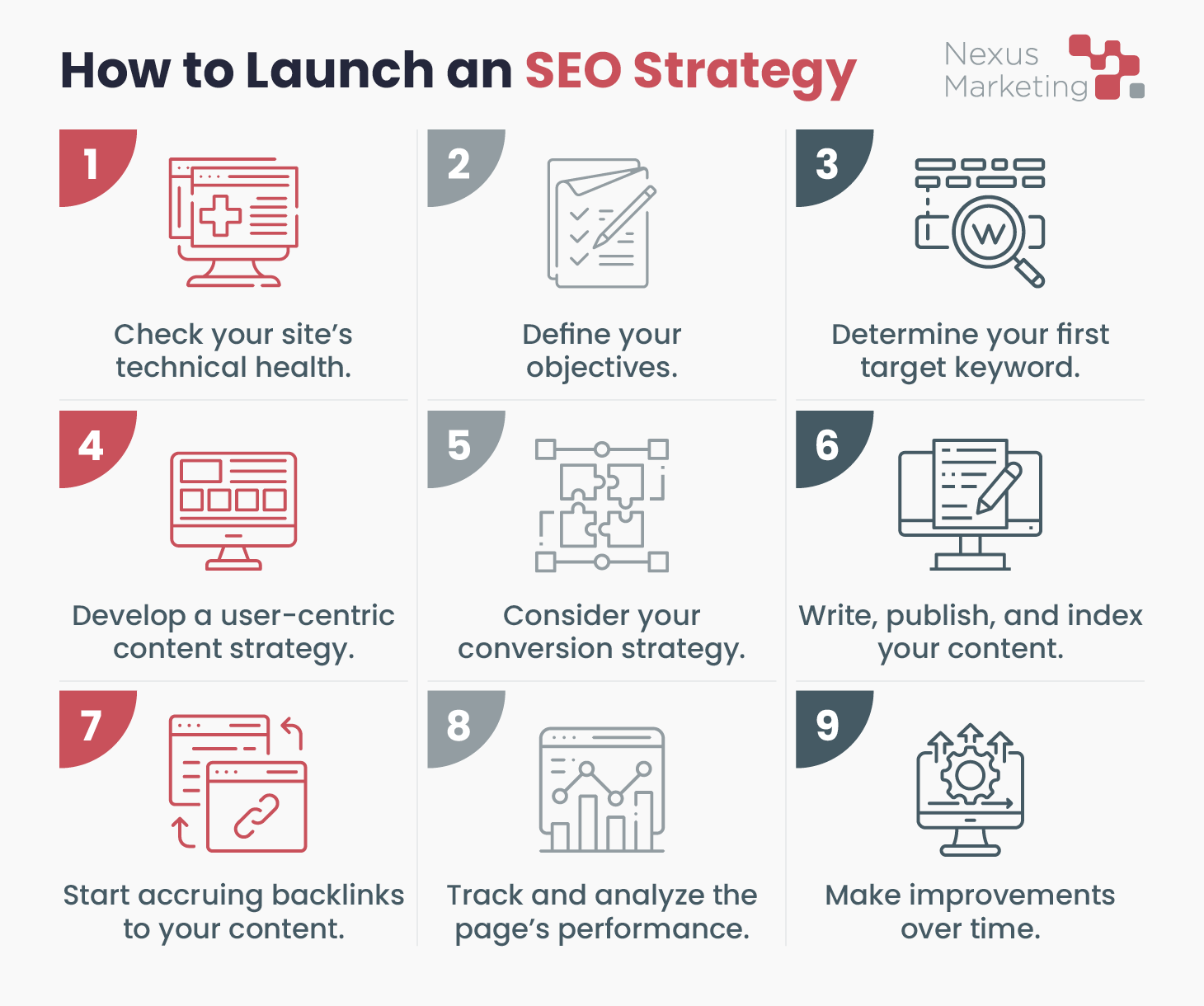
1. Check your site’s technical health.
Start with a quick website check-up:
- Ensure that your pages are indexing properly using Google Search Console.
- Install Google Analytics on your website and learn how to use it.
- Check your website’s load speed to identify any serious technical issues.
- Consider investing in a dedicated SEO tool like Semrush or Moz (our favorites).
For complete coverage and diagnostics, we recommend conducting a full technical SEO audit. Please contact us to learn more about this process and what it entails.
2. Define your objectives.
What are the core organizational objectives that you want to accomplish with SEO?
Remember, these should revolve around demand generation. Is there a particular offering or aspect of your association’s operations that you want to focus on first? These might include:
- Boosting member recruitment
- Selling more training products or services
- Securing more registrants for your next annual event
Under these objectives, you’ll set more tactical goals, like reaching Page 1 ranks for a certain number of your target keywords or increasing conversions on a specific landing page by X%.
3. Determine your association’s first target keyword.
Based on your most important objective, choose your first target keyword to pursue.
Ideal keywords for quick wins live in the “Goldilocks Zone” of high demand and low competition. This means it’s a topic searched by qualified leads but without a ton of other high-authority websites crowding the SERPs with standout content. Writing a stellar article that educates this audience and introduces your offering can drive value relatively quickly.
SEO tools often have their own proprietary methods of gauging a keyword’s competitiveness. Moz’s Keyword Explorer is one of the easiest to use.
But you know your space (and your competitors and peer organizations), too—reviewing the existing SERPs of potential keywords can also give you a quick idea of who’s pursuing them and the caliber of content you’ll be up against.
Reminder: Don’t target a broad, high-traffic keyword just yet. In many cases, these are the most competitive terms to rank for.
More specific keywords searched by users who are already lower in the sales funnel will give you the faster wins and momentum that your strategy needs!
SEO agencies can help you lay out a more comprehensive keyword strategy and roadmap based on your objectives and the competitiveness of your space. This is one of the first steps that we take with new clients here at Nexus. Thorough upfront keyword research pays off!
4. Develop a user-centric content strategy.
Outline an article that will help you rank for your target keyword. Your association’s website may already contain an article that could rank if you update and improve it!
We recommend following these steps to sketch out a winning content strategy:
5. Consider your conversion strategy.
Before finishing your outline, take a moment to carefully think through exactly how you’ll ask readers to convert—take a specific action that supports your organizational objective.
Depending on the context, this target conversion action might be:
- Requesting information about joining your association
- Downloading a free digital resource
- Purchasing a product or service
- Registering for your annual event
Think about your audience, their goals for searching the target keyword, and how your offering aligns with that user intent. Pinpoint sections in your outline where you can promote your offering and ask users to take action.
These calls-to-action (CTAs) are often formatted as buttons, banners, and branded graphics that catch the eye. But however you handle your CTAs, make sure that they link straight to a landing page where users can take the target action. Common landing pages include contact or signup forms, lead capture pages to collect email addresses, and specific product/service pages.
6. Write, publish, and index your content.
Now comes the fun part!
Draft your article, give it a short and intuitive URL that includes the target keyword, review your draft, and make revisions. Bonus points for engaging visuals and videos—users and Google appreciate them! Make sure that your article is also attributed to an author, ideally a real person at your association, but a more generic byline simply listing your association can suffice.
Hit publish, and then head over to Google Search Console. Search your new article’s URL and “request indexing.” This will fast-track the indexing and ranking process for your content
7. Start accruing backlinks to your association’s SEO content.
Once your content is live, you can begin the process of building backlinks to it.
Remember: Backlinks show Google that your content is trustworthy, a key component of quality and ranking power.
Start with internal links. Identify several other high-quality pages on your association’s website where a link to your new content would make sense and enhance the user experience.
Next come external links to your content from other websites. This is a diverse practice all on its own. Authority-building by securing backlink placements with external partners is a core part of our own process here at Nexus. The most common ways to secure backlinks include:
- Writing short guest blog posts for other websites that include a link to your SEO content.
- Finding mentions of your association on other websites using a quote search operator, then reaching out to those websites to request a link to your content.
- Taking the organic route by more generally building your brand’s visibility as it relates to that topic.
- For example, social media posts and links don’t directly contribute to SEO success, but they do spread the word about your content and can encourage other websites to build links organically.
Extra Context: Ethical Link-Building
Over the years, building backlinks has seen a lot of practices and trends come and go.
There is such a thing as unethical and improper link-building.
Spammy websites may use shady practices to build tons of links to their content in comments, forums, and garbled AI-generated content. Do not use these practices, and don’t hire any SEO vendors that use them.
Google can issue manual actions if it detects that a site is violating its spam policies. Manual actions penalize a website and prevent it from ranking well in the future. Not to mention, Google algorithm updates increasingly combat these practices and the rise of spammy AI content head-on. Trying to take a shortcut will result in headaches, not success.
Instead, accrue backlinks organically. Good content naturally secures links as it travels the internet. Reach out to your actual partners and peers to ask for links and blogging opportunities. These natural-looking links are much more valuable and worth your time.
Extra Context: The Importance of Brand-Building
Building brand recognition is increasingly important for SEO, although often in a somewhat indirect way.
In the age of AI, Google pays extra attention to names and brands that it understands to be recognized, connected, and respected in their topic areas. Cross-blogging with other websites is one way to build your association’s brand, but remember that any positive publicity online can help.
At Nexus Marketing, our extensive partnership network has been a core part of our clients’ successes.
By building relationships with hundreds of high-quality, recognized brands in the mission-driven space, we can plug our clients right into the action.
Other activities like industry speaking engagements, influencer partnerships, and various digital PR opportunities all build your brand’s profile, as well. We’ve even built out an entire community, NXUnite, dedicated to fostering these connections between nonprofits, associations, businesses, and their audiences!
8. Track and analyze your page’s performance.
As you continue building links and your brand’s visibility, keep track of how your content is performing.
If you’ve invested in a dedicated SEO tool or professional SEO services, this is easy. You can access performance reports or receive them straight from your SEO agency—check out how we handle reporting with easy-to-use dashboards.
On your own, you can also use Google Search Console and Google Analytics to track your content’s visibility, traffic, and more. Just remember to dig deeper than topline numbers. Actual conversions—the number of users who take your target conversion action—are ultimately the most important metric for success.
This is why it’s essential to have a clear conversion strategy on your SEO pages. When you understand exactly what you’re asking readers to do and link your CTAs straight to the place to take action, you can easily measure clickthroughs to that landing page and the number of form completions.
9. Make improvements over time.
Finally, take all of the insights you’ve learned from keyword research, the content creation process, and your page’s performance metrics to make improvements over time.
It’s a good idea to regularly revisit your SEO content to audit its performance and compare it to fresher content on the SERP. We typically schedule these kinds of “refresh” activities for our clients because Google highly values fresh, actively maintained content. This is also when you can make improvements to your conversion strategy if needed.
Congrats! If you’ve followed along, you’ve just rolled out a preliminary SEO strategy for your association.
The beauty of this process is that it’s so easily repeatable. You just need the capacity to make research, content creation, and data analysis part of your ongoing marketing practices—which is why so many brands choose to partner with SEO agencies.
Hiring an SEO Agency for Your Association
Associations hire SEO agencies to handle the ongoing and day-to-day work of running an SEO strategy.
Successful strategies take dedicated time and effort, which is why they’re often postponed by busy organizations.
SEO agencies bring specialized experience and technical know-how that most organizations don’t have in-house.
Working with experts is the most effective way to get an SEO strategy off the ground, especially when they offer:
- Technical SEO audits
- Custom content creation
- Link-building services
- Networks of relevant partners in your industry
- Additional PR opportunities for your brand
These comprehensive services can support the whole lifecycle of your association’s SEO strategy, turning it from a time-consuming activity for your team to a revenue-generating channel that runs in the background. The right vendor will work with you to develop a custom strategy, maintain the health of your website, and let you be as hands-off (or hands-on) as you want.
So how do you hire one? We recommend these general steps:
Why Nexus Marketing Stands Out
Nexus Marketing is the leading SEO agency in the mission-driven space.
We’ve helped diverse organizations and businesses thrive online, reach the right audiences, and build powerful brands for a decade. Check out our case studies!
What sets us apart? Deep expertise in mission-driven subject matter and extensive, organic connections in the space.
Plus, we offer a full range of additional content creation and PR opportunities to take your brand’s online visibility to the next level. Between custom email and video production, our influencer marketing program, and constant industry speaking opportunities, we’ve got you covered. These options allow you to drive both short- and long-term ROI, unique among SEO agencies.
Please contact us or learn more about our approach. Tell us about your association’s demand generation goals, and we’ll lay out a plan to reach them.

Learn More about SEO: Recommended Resources
Want to learn more about SEO for associations? Check out our recommended resources:
- Explore the Nexus blog for more guides and updates straight from the source.
- Take a deep dive into industry news with Search Engine Journal.
- Check out the Moz and Semrush blogs, our preferred SEO software providers, for more expert insights and guides.
Finally, don’t hesitate to reach out to us with any questions. Curious about anything covered in this guide? Have a unique SEO challenge in mind? We’re always happy to chat about SEO and the latest trends!
